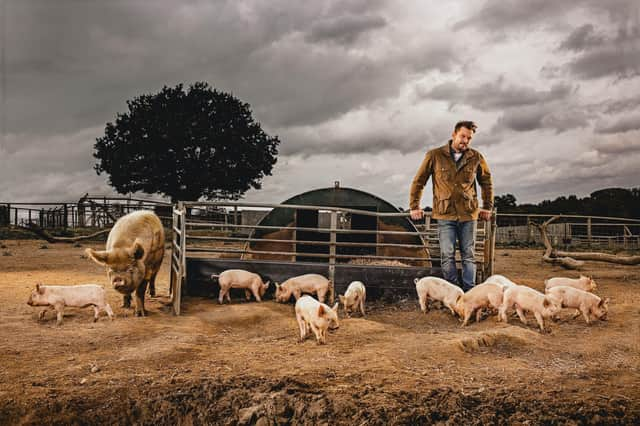He’s back! Autumnal adventures arise on Jimmy’s Farm


Jimmy Doherty doesn’t pull any punches when it comes to reiterating just how inaccurate the stereotypes attached to the modern farmer are.
“Yes, we have an archetypical farmer, and yes, it’s an ageing population, and I get all that,” he says.
Advertisement
Hide AdAdvertisement
Hide Ad“But when it comes to the farming industry, the job role itself is so far removed from the bucolic view of the old boy with the cap leaning on the gate.
“The reality is, you’ve got to be an engineer, you’ve got to be a vet, you’ve got to be a social worker, a economist, an entomologist.
“And it’s a very complex job that’s a mixture of everything, science and a bit of alchemy as well.”
His articulation alone betrays, indeed, just how far removed Jimmy is himself from those old, tired, clichés and assumptions about the characteristics of the rural farmer.
Advertisement
Hide AdAdvertisement
Hide AdA university and PhD graduate, the 45-year-old TV personality has been allowing viewers all over the nation to see for themselves what life’s really like on working pig farm for more than a decade now.
And at the minute, his brand new series, Autumn at Jimmy’s Farm, has just kicked off, hot on the heels of the success of his offering earlier this year, Spring at Jimmy’s Farm.
Filmed by just a small crew, fans are getting to see the 280 acre site, deep in the Suffolk countryside, which includes woodland and an animal park full of exotic animals, that Jimmy, his wife Michaela, and their four daughters and herd of sheep and pigs call home.
Offering wildlife, food, farming, gardening and science, this four-part series will gives families cooped up indoors the chance to see autumn in the countryside unfold week by week.
Advertisement
Hide AdAdvertisement
Hide Ad“Yeah, it’s going really well so far!” says Jimmy in his unmistakable Essex accent.
“When we did this back in the spring, it was during lockdown, and people really wanted to get outside and get connected with the outdoors again, so they were enjoying following the ups and downs of the animals, and now it seems they’re interested in what’s happening in the autumn.”
And it’s that pure authenticity that Jimmy feels certain is in no small way responsible for the show’s success.
It’s all about, to coin a modern day phrase, ‘keeping it real.’
Advertisement
Hide AdAdvertisement
Hide Ad“We don’t really hide anything,” he says. “There are lovely moments and lots of fun and laughter, but also life and death in it. If it happens, then it is reality, and we show it.
“I think that one of the biggest problems when it comes to food production is that most consumers are a million miles away from the source of their food, and the closer we can get the consumer to understand about food production sees those sort of ‘jerk back’ moments you get.”
One such moment, he reveals, on this series, is when one of his pigs has a heart attack.
But these kind of moments are not the kind to ever have deterred Jimmy from a career in farming himself - despite all the associated long hours and hard graft that comes with it.
Advertisement
Hide AdAdvertisement
Hide Ad“I love natural history, and I used to collect lots of little animals as a kid,” he recalls.
“I had weird pets and stuff and worked at a wildlife park from the age of 13 to 25 in the school holidays
“I used to keep chickens and my mate’s dad used to keep rare breeds; he had Gloucester cattle and Dexter cattle, and Ryeland sheep. I remember walking down a lane at night shining a torch to watch the birth of a ewe lamb. That had a big influence on me.”
Jimmy set about making his dream of being a farmer come to fruition by renting a derelict one, around which he built a fence to house livestock, and then built a butcher’s unit with second hand fridge panels.
Advertisement
Hide AdAdvertisement
Hide Ad“I bought a couple of pigs to kill and breed, and went to a good market in Covent Garden, where I sold the produce, and came back and bought some more pigs with that, and slowly built up.”
He reveals that at the time it was cheaper to rent his farm that a flat in Walthamstow, and I remark that it was surely the best investment he ever made?
“Well at times it felt like a chain around my neck,” he laughs.
Fast forward to now, and Jimmy hasn’t looked back.
And he’s passionate about leading the charge in terms of ensuring farmers do not get unjustly slated for their practices.
Advertisement
Hide AdAdvertisement
Hide Ad“With the right incentives, farmers could be totally leading the charge when it comes to reversing the effects of climate change and biodiversity loss,” he says.
“It’s so easy for journalists to pick up on the subject matter and tell a farmer what he’s doing wrong.
“And also it’s an industry that is fairly understated in terms of defending itself. Many farmers would rather keep quiet and carry on, as opposed to saying, that’s not actually correct.
“Years ago the farm would have been at the heart of the community, but I think people have gone further away from that. Nowadays it’s all about going into the supermarket and picking up a packet - nobody knows who their local farmers are.
“And when you get that distancing between the producer and the consumer, then it becomes a problem.”
**Catch up with Autumn at Billy’s Farm on Wednesday nights at 8pm on Channel 4.
Comment Guidelines
National World encourages reader discussion on our stories. User feedback, insights and back-and-forth exchanges add a rich layer of context to reporting. Please review our Community Guidelines before commenting.